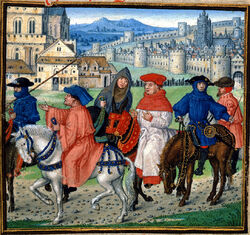
Introduction of Chaucer, Age of Chaucer, Arrival of Renaissance in England , Prologue to Canterbury Tales
Geoffrey Chaucer (/ˈtʃɔːsər/; c. 1340s – 25 October 1400) was an English poet and author. Widely considered the greatest English poet of the Middle Ages, he is best known for The Canterbury Tales.He has been called the "father of English literature", or, alternatively, the "father of English poetry". He was the first writer buried in Poets' Corner of Westminster Abbey.[3] Chaucer also gained fame as a philosopher and astronomer, composing the scientific A Treatise on the Astrolabe for his 10-year-old son Lewis. He maintained a career in the civil service as a bureaucrat, courtier, diplomat, and member of parliament.
Among Chaucer's many other works are The Book of the Duchess, The House of Fame, The Legend of Good Women, and Troilus and Criseyde. He is seen as crucial in legitimising the literary use of Middle English when the dominant literary languages in England were still French and Latin.
The Renaissance was a fervent period of European cultural, artistic, political and economic “rebirth” following the Middle Ages. Generally described as taking place from the 14th century to the 17th century, the Renaissance promoted the rediscovery of classical philosophy, literature and art.
What does Renaissance Mean?
The name ‘renaissance’ is a French word translating to rebirth. It symbolised the beginning of a new era of art, rebirthing the classical models of Ancient Greek and Rome periods while using the modern techniques.
When did this era begin?
There is not an exact date of the beginning of the Renaissance period, but it was rumoured to begin in the period from 1350 until the year 1400. Starting in Florence, Italy, before spreading out to the rest of the country. Prior to the Renaissance period, in the middle ages, people thought life should and always be hard. It was a world filled with war and hard work, with citizens working themselves into the ground until they perished. However, by the 1300s, the people of Florence began to think differently. Studying the past lives of the Greeks and Romans, they realised that life could be done in another way, which introduced the new way of thinking called humanism. Using the comforts of life, reawakening art, culture, science, technology, and music to bring more joy into life. As Italy was a considerably wealthy country at the time, it was easy for them to extravagantly spend their money on the finer things of life, cultivating humanism quickly. Wealthy merchants hired artisans and craftspeople more frequently. As well as competitions among artists and thinkers occurring more frequently. Art began to flourish, and new thoughts began to emerge. With the entire continent spending more and more money on the fine arts. This began the foundation for the European age of exploration, which soon led to Europe’s global power.
How long did the Renaissance period last?
The end of the Renaissance period ties in directly with Florence’s decline. It first began with the invasion of Florence by France in 1494, as well as Italy, breaking into warfare between its city-states. The introduction of the Renaissance gave birth to many political and intellectual movements, with the era having a large backlash. By the 1550s, many of the artworks and literature that helped developed the Renaissance were banned. And by the mid-1550s, the Renaissance was over completely in Italy. However, it was live alive across Europe, with other country’s growing this era even after Italian’s end.
What made the Renaissance Period so significant?
The Renaissance period cultivated a new change in art, knowledge, and culture. It changed the way the citizens thought, with first the rediscovery of classical philosophy, literature, and art, as well as the new discoveries in travel, invention, and style. This era was so important has it changed the way the world thought, with new inventions, styles, and explorations that are still influential and occurring to this day. The term ‘Renaissance Man’ refers to the highly influential people who shaped this period of time. They were masters of invention, engineering, creatively, and travel, with some of there discoveries and inventions still used widely to this day.
The Canterbury Tales, the work stands as a historical and sociological introduction to the life and times of the late Middle Ages. During Chaucer's time, regardless how brilliant and talented one might be, there was no way for a commoner to move from his class into the aristocracy. Chaucer, however, made that leap as well as anyone could. As a commoner, he was familiar with and was accepted by the lower classes as well as by the higher classes; thus, throughout his life, he was able to observe both the highest and the lowest, and his gifted mind made the best of these opportunities.
Chaucer's genius at understanding basic human nature made him the great poet he was. He knew the world from many aspects, and he loved most of his characters. The mature adult would find it difficult not to like such characters as The Wife of Bath, even with all her bawdiness, or the Miller with his vulgarity that amuses rather than offends sophisticated readers. Chaucer presents the world as he sees it, and he shares one quality with all great writers: He is a delight to read.


